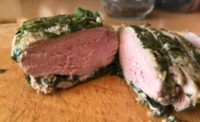Celebrating the year of the duck

Today, Long Island is home to everything from some of New York City’s busiest airports to some of its trendiest neighborhoods. Once upon a time, though, Long Island was known for its duck farms. The Jurgielewicz family was one of the original duck farmers on the island, and while those times have passed, the family is still very much involved in the duck industry. Joe Jurgielewicz & Son Ltd., located in Shartlesville, Pa., is continuing four generations of family tradition in agriculture.
The family had, at one point, gotten out of the duck business, says Joey Jurgielewicz III. His grandfather had sold the business out to his brothers, but Joe II went to Cornell to become a veterinarian.
“After he graduated, he wanted to be a duck farmer. So they found some property in Pennsylvania and started there again,” Jurgielewicz said.
The family business eventually grew to become a vertically integrated duck producer and processor, working with about 25 contract family farmers to raise the birds. The company offers everything from duck wings, breasts and legs to a whole duck, as well as specialty items like duck sausages, duck feet and rendered duck fat.
About three-quarters of the company’s business comes from the Eastern trade in North America. Chinese restaurants that sell Peking duck prefer a head-on, feet-on duck. The Chinatown neighborhoods of metropolitan areas like Chicago, San Francisco and New York City are major markets for the company.
“If you go to some of the Chinese barbecue shops and you see the ducks hanging there, that would be from our farm,” Jurgielewicz says.
The fastest-growing market, however is the white-tablecloth restaurant sector. The Wall Street Journal ran an article in January about what’s in and what’s out on restaurant menus in 2018. Kale and even sirloin steaks are down, and one of the growing menu items was duck meat. The foodservice industry helps drive trends at retail, so when consumers start to see duck appear more often on menus, they become more curious about trying the product at home.
Jurgielewicz says that the company’s sales team works hard cooking and doing demos wherever possible. He was recently at the Charleston Food & Wine Festival, where duck was being served at the culinary village for interested attendees.
“I love it when you find someone that's never had duck before and, when they say they'll try it, we can get them pumped right away,” he says. “There's so much potential out there for us on it. It's just hitting the streets and just getting people to try it.”
To help consumers get introduced to duck, Jurgielewicz and Son offers some recipes on its website, categorized both by product type (breast, wings, etc.) and meal type. The Pan Seared Jurgielewicz Duck Breast is an excellent starter recipe, while something like Duck Legs Deglazed with Ice Cider on Vegetable Corolla would appeal to the more adventurous home chefs.
When it comes to processing, most of the work is still done by hand. The company does use some automation where possible, but the quality that’s demanded by its customers requires hand work, Jurgielewicz explains.
“If you have a 5-pound duck versus a 6-pound duck going through an automatic eviscerating machine, it will cut that vent a little bit too big, and it will just mess up the cooking processes. So the human hand still is a lot softer touch than the machines. That's why we actually prefer that,” he says.
Looking for a reprint of this article?
From high-res PDFs to custom plaques, order your copy today!







